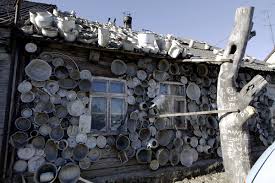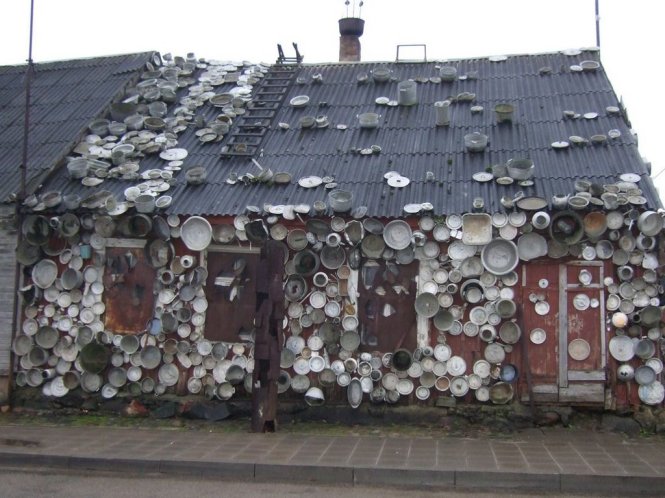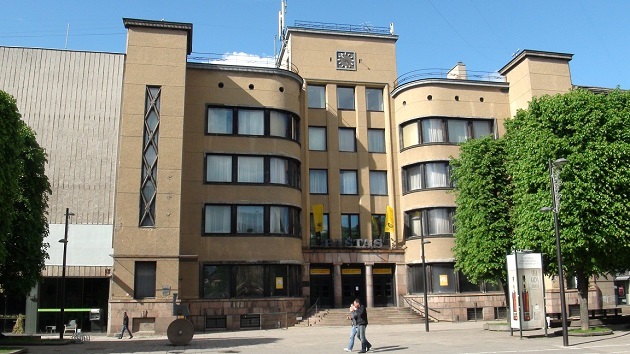floating city
Floating City Concept #1
House of Pans
“Educated to be a mechanical engineer, Vaiciulis’ refusal to conform to the dress code at work led to his career in the field lasting about one week. This only strengthened his dedication to individualism, and his voice was a loud one when it came to politics and community business in his Lithuanian town of Zagaré. His engineering skills and colorful personality naturally led him towards artwork, and he began to carve large wooden sculptures; busts and bears and old men, all out of former tree trunks.
When privatization was introduced after the Soviet Union split in the early 1990s, Vaiciulis purchased half of a house, which he was set on rebuilding. Unfortunately, the neighbors who shared ownership had no interest in the lofty endeavor, and so Vaiciulis had to find a different way to make it his. His neighbors had to agree to rebuild the infrastructure, but designing the outside was something they had little jurisdiction on. Vaiciulis began to make his house as unique and unconventional as he was.
Soon, the outside of the house was slowly but surely covered in found objects. Pots and pans made up the bulk of the unusual siding, but metal plates and a plethora of household objects, as well as machine parts and random metal pieces were thrown into the mix. The garden was filled with many of his wooden sculptures along with more found objects of interest, and the barn wall was adorned with several animal skulls.
Called “The Pan House” Vaiciulis’ house is now the most photographed home in Zagaré, and welcomes individuals and groups to come and take a look. ” (1)

Kaunas Culture & Traditions
Local people are very hard-working. This character trait has even found its reflection in the folk art. Most of the songs are devoted to work and labor. Even fairy tales and legends tell stories about brave and hard-working heroes. There are special literature classes in schools, during which children learn ancient myths and fairy tales, so even small kids are familiar with national folklore. Many national holidays are connected with various religious traditions. One of such holidays and one of the most popular festivals in the city is called Uzgavenes. This holiday also marks the beginning of Lent.
This colorful carnival is particularly loved by children, because delicious pancakes and sweets are the main treat of this wonderful event. The carnival is held on the last days of February. Saying “goodbye” to winter is always accompanied by parades, musical performances and funny activities for children. Collective performances remain one of the main features of local culture. Performances of choirs and various dance groups during holidays and celebrations have become a tradition.
Nomadic Tribe
“The Nomadic Tribes and Denotified Tribes consist of about 60 million people in India, out of which about five million live in the state of Maharashtra. There are 315 Nomadic Tribes and 198 DenotifiedTribes.” (1)
LIST of different types of Nomadic People
“Nomadic people are communities who move from one place to another, rather than settling permanently in one location. Many cultures have traditionally been nomadic, but nomadic behavior is increasingly rare in industrialized countries.” (2)
(2) https://en.wikipedia.org/wiki/List_of_nomadic_peoples#Europe
The house of Pots

“Educated to be a mechanical engineer, Vaiciulis’ refusal to conform to the dress code at work led to his career in the field lasting about one week. This only strengthened his dedication to individualism, and his voice was a loud one when it came to politics and community business in his Lithuanian town of Zagaré. His engineering skills and colorful personality naturally led him towards artwork, and he began to carve large wooden sculptures; busts and bears and old men, all out of former tree trunks.
When privatization was introduced after the Soviet Union split in the early 1990s, Vaiciulis purchased half of a house, which he was set on rebuilding. Unfortunately, the neighbors who shared ownership had no interest in the lofty endeavor, and so Vaiciulis had to find a different way to make it his. His neighbors had to agree to rebuild the infrastructure, but designing the outside was something they had little jurisdiction on. Vaiciulis began to make his house as unique and unconventional as he was.
Soon, the outside of the house was slowly but surely covered in found objects. Pots and pans made up the bulk of the unusual siding, but metal plates and a plethora of household objects, as well as machine parts and random metal pieces were thrown into the mix. The garden was filled with many of his wooden sculptures along with more found objects of interest, and the barn wall was adorned with several animal skulls.
Called “The Pan House” Vaiciulis’ house is now the most photographed home in Zagaré, and welcomes individuals and groups to come and take a look.” (1)
Hill of Crosses
“The Hill of Crosses is a site of pilgrimage about 12 km north of the city of Šiauliai, in northern Lithuania. The precise origin of the practice of leaving crosses on the hill is uncertain, but it is believed that the first crosses were placed on the former Jurgaičiai or Domantai hill fort after the 1831 Uprising. Over the generations, not only crosses, but giant crucifixes, carvings of Lithuanian patriots, statues of the Virgin Mary and thousands of tiny effigies and rosaries have been brought here by Catholic pilgrims. The exact number of crosses is unknown, but estimates put it at about 55,000 in 1990 and 100,000 in 2006.” (1)
according to a list which was published by the CNN, an office building in Kaunas which had decorated a 1000 LTD banknote was considered as one of the top eleven strangest buildings in Europe.
InterWar Architecture
“Rebirth of independent Lithuania in 1918 gave a new impetus on construction. Initially the earlier historicist trends were continued. This changed soon and the most productive decade of interwar architecture (1930s) was heavily influenced by art deco style and Bauhaus movement.” (1)

(1) http://www.truelithuania.com/interwar-architecture-in-lithuania-1918-1944-62